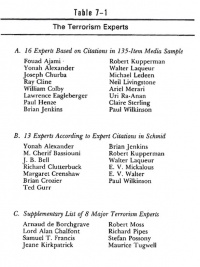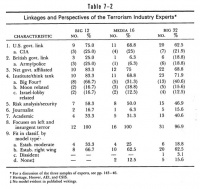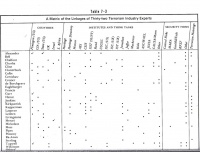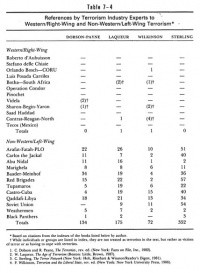The Experts extract from The "Terrorism" Industry
This page is an extract (chapter 7 'The Experts') from Ed Herman and Gerry O'Sullivan, The "Terrorism" Industry, 1989, Pantheon, pages . It is reproduced with the permission of Ed Herman.
The Experts
The link between the institutes/think tanks and the mass media is provided by the large body of experts on terrorism, or "terrorologists," who publish books, articles, and monographs through leading publishing houses, the mainstream press, and newsletters and journals issued by the various institutions that house them. They count among their ranks right-wing journalists and policy analysts, former military and intelligence officers, ultraconservative academics, counterinsurgency specialists, FBI informants, and CIA contract employees. A significant number of these experts are affiliated with ultra-right-wing organizations such as the WACL, CAUSA, the ASC and its affiliate, the WACL-based Coalition for Peace Through Strength, and the John Birch Society.
With the aid of their sponsoring organizations, these experts attend one another's conferences and seminars, serve on the editorial advisory boards of one another's journals (such as Terrorism and Conflict Quarterly), review and write forewords for their colleagues' books, and cite one another copiously. Through this mutually supportive network, these experts establish their facts as true and their very similar assumptions and opinions as mere common sense. They validate themselves by echoing one another in an information market which they dominate. There are other individuals knowledgeable about the issues terrorologists address, but they start from the wrong premises, are not funded by the institutes and think tanks of the terrorism industry, and are thus not properly accredited. Furthermore, their discordant views do not mesh well with the commonsense understanding of the issues established by the government, industry members, and press, and they are generally excluded from serious discussions in public forums that reach large numbers of people. [...]
In this chapter we will examine more closely some of the characteristics, links, and opinions of the preeminent terrorism experts. Our hypotheses are: (1) private-sector experts will tend to be affiliated with governments, or to have been so connected in the recent past; (2) they will often be associated with institutes and think tanks organized to push established views, many with a strong right-wing bias; (3) many of them will be linked directly or indirectly to the international ultra-right, exemplified by the Unification Church system and WACL; (4) many will be connected with private-sector security firms; and (5) the experts will rarely if ever depart from the official Western model and line on terrorism, and given the right-wing bias of the institutes, will, in fact, tend to expound the far-right version of the line.
A Survey of the Experts
Ultimately, we are most interested in those analysts of terrorism who are accredited as experts by the mass media, and who are thus allowed to define the issues and are given access to the public. Experts also include those who are cited frequently by specialists in the field and mobilized as witnesses at hearings and participants in conferences. Table 7-1 lists first (A) the 16 leading experts on terrorism based on citations from our mass media sample of 135 news items on the subject. [1] It also lists (B) 13 experts based on number of references to their work by other terrorism experts, as reported in Schmid's volumes on political terrorism. [2] There are 5 individuals common to lists A and B, so that the two together provide
Table 7-1 The Terrorism Experts
A. 16 Experts Based on Citations in 135-Item Media Sample
- Fouad Ajami
- Robert Kupperman
- Yonah Alexander
- Walter Laqueur
- Joseph Chorba
- Michael Ledeen
- Ray Cline
- Neil Livingstone
- William Colby
- Ariel Merari
- Lawrence Eagleberger
- Uri Ra-Anan
- Paul Henze
- Claire Sterling
- Brian Jenkins
- Paul Wilkinson
B. 13 Experts According to Expert Citations in Schmid
- Yonah Alexander
- Brian Jenkins
- M. Cherif Bassiouni
- Robert Kupperman
- J. Bowyer Bell
- Walter Laqueur
- Richard Clutterbuck
- E. V. Mickalous
- Martha Crenshaw
- E. V. Walter
- Brian Crozier
- Paul Wilkinson
- Ted Gurr
C. Supplementary List of 8 major Terrorism Experts
- Arnaud de Borchgrave
- Robert Moss
- Alun Chalfont
- Richard Pipes
- Samuel T. Francis
- Stefan Possony
- Jeane Kirkpatrick
- Maurice Tugwell
24 separate experts. To this set of 24, we have added 8 supplementary names (C), based on our judgment of importance as measured by influence and outreach. Lord Alun Chalfont, a former British cabinet minister and an active journalist and publicist, was chair of the Jonathan Institute conference of 1984 in Washington, chairs the Institute for the Study of Terrorism in London, and links together diverse governmental and right-wing interests in the terrorism industry. Arnaud de Borchgrave runs a newspaper and magazine, writes fictional accounts of terrorism (which he and his coauthor Robert Moss discuss in interviews as though they were factual). [3] and effectively exploits his numerous connections to get his message across. Samuel T. Francis is the leading Heritage Foundation authority on terrorism and has had substantial outreach through his writings and participation in conferences, hearings, and interviews. Jeane Kirkpatrick, following her stint as the Reagan UN ambassador, has been a syndicated columnist, lecturer, and foreign policy expert associated with a number of institutes and think tanks. A cult figure of the right, she has had substantial outreach as a commentator on terrorism. Robert Moss, an Australian-born British journalist, has been affiliated with a number of right-wing institutes, several of which he helped to organize, and has been a prolific writer of fictional and quasifictive accounts of the terrorist threat. The fictional accounts have been written in collaboration with de Borchgrave; the quasifictive accounts have frequently been written under the direction or with the cooperation of various Western intelligence agencies.[4] Richard Pipes, the Harvard specialist in Soviet studies, is included because of his multiple affiliations in the industry, his writings, and his important role in the Jonathan Institute conference of 1979. Stefan Possony, the leading terrorism expert in residence at the Hoover Institution, and also a longtime member of WACL and ASC, has written extensively on terrorism, including a book written with L. Francis Bouchey, 'International Terrorism: The Communist Connection'. Finally, Maurice Tugwell, a former British army information officer, now a resident of Canada and head of the Mackenzie Institute, is included here as the most influential Canadian terrorologist, with wide-ranging activities in this field in Canada.
Let us turn now to an examination of some of the major experts, to get a sense of the scope and character of their activities, as well as to provide basic information on their linkages and views on terrorism. Following these accounts we will try to arrive at some generalizations about the connections and positions on terrorism of all 32 experts.
- Yonah Alexander
- Ray Cline
- Brian Jenkins
- Robert Kupperman
- Walter Laqueur
- Michael Ledeen
- Neil Livingstone
- Ariel Merari
- Robert Moss
- Claire Sterling
- Maurice Tugwell
- Paul Wilkinson
The Linkages and Opinions of the Establishment Experts
In this section we shall try to draw some conclusions about the institutional connections of and positions taken by the terrorism experts. In table 7-2 the institutional connections of these experts are shown on an aggregated basis in rows 1 through 7, and some important characteristics of their opinions and perspectives can be seen on rows 8 and 9. Column 1 of the table provides this information for the 12 experts discussed earlier in this chapter. Column 2 supplies this information for the 16 individuals who were the experts of choice in our media sample (see table 7-1). Eleven of the set of 16 were discussed above in our sample of important experts. The third column gives similar data for a larger set of 32 leading experts on terrorism, which includes all of those in the first two columns, plus 15 others, identified earlier in table 7-1 and the text. It can be seen that the differences in connections and opinions between these three sets are small.
The table offers striking confirmation of our major hypotheses. First, we can see on rows 1-3 how closely the experts are linked to governments. Over two-thirds have had some U.S. or British government affiliation in the recent past, and between a fifth and a quarter have had a CIA connection (row 1a). Conferences on terrorism commonly include as major speakers both the privatesector experts and government officials, who operate collegially and on the same premises and are hard to tell apart. William Casey, head of the CIA during much of the Reagan era, was the featured speaker at the 1985 conference on terrorism at the Fletcher School of Law and Diplomacy, addressing the subject "The International Linkages: What Do We Know?" Casey fitted in smoothly; the experts had no problems with accommodating the activist head of an activist intelligence agency into the scholarly proceedings.
Table 7-2 Linkages and Perspectives of the Terrorism Industry Experts'
These linkages between governments and the terrorism experts suggest the strong likelihood that the experts will adhere to a government party line; or, put another way, they point to a certain lack of independence on the part of these experts. This should raise questions about their suitability as sole sources for a supposedly independent � not to say adversarial � press. It is a striking fact that the media not only do not seem to have qualms about this lack of independence, they do not appear to be aware that this is a problem. The assumptions and truths of the state are so taken for granted that a symbiotic relation between state and "independent" press is not seen to contaminate the press function. This even extends to an unquestioning (and often undisclosed) use of CIA, ex-CIA, and other intelligence functionaries in the disinformation-propaganda line (Colby, Cline, Crozier, Henze, Moss, Tugwell, etc.), who are treated as presumably objective news sources and analysts. Only in other countries does government domination of information and opinion used by the press compromise press integrity.
A second theme of this analysis of experts is that, in order to mobilize bias, the government and corporate elite have nurtured those with the proper views by providing them with financial support and institutes in which to work. It can be seen on row 4 of table 7-2 that over two-thirds of the experts have been affiliated with institutes and think tanks. As we described in chapter 5, many of these organizations have been funded and otherwise supported by dominant establishment institutions-corporations, corporate foundations, the government, and the wealthy heirs of the corporate system. This funding and support relationship is conspicuously true of the Big Four institutes - Heritage, Hoover, CSIS, and AEI - with which a very sizable fraction of the experts have been associated. We can see on row 4a that 66.7 percent of the Big Twelve sample of experts, and a somewhat smaller proportion of the total sample (column 3) have been affiliated with this leading foursome. It can also be seen on rows 4b and 4c that there are significant connections between the mainstream terrorism experts and Moon-supported institutes and those affiliated with the Israeli lobby.
Table 7-3 A Matrix of the Linkages of the Thirty-two Terrorism Industry Experts
On row 5 of table 7-2 we can also see that about half or more of the mainstream experts have been affiliated with private firms in the risk analysis and security business. This linkage tends to compromise them as experts on terrorism, partly because they sell their services to businesses and governments who have restricted views on the nature of terrorism. They also have a vested interest in "threat inflation," as their business is contingent on an adequate volume of terrorism against which to protect their clients. Security business also ties the participants more closely to the government security establishment in exchange of information and a revolving door relationship.
Five of the establishment experts are journalists, and a larger number are academics. These relationships often overlap with ties to government and the institutes (see table 7-3). Arnaud de Borchgrave, Brian Crozier, Robert Moss, and Claire Sterling are classed as journalists, but the first three have had important links to governments and institutes; Sterling has been funded by the 'Reader's Digest', which has had long-standing CIA connections,[5] and her links to Western intelligence agencies and the various terrorism institutes and experts have been collegial and mutually supportive. Roughly one-third of the experts have had an academic connection (row 7), but a great majority of these experts have also had links to governments, the institutes, and risk analysis firms. This is evident among the most prestigious experts, who are also most heavily cited by the media, such as Laqueur and Wilkinson. The relatively sizable contingent of academics in column 3 results from the fact that the sample of 32 includes those listed by Schmid as heavily cited by other experts, who refer to some of the more esoteric and quantitative literature by E. V. Walter, M. Cherif Bassiouni, Ted Gurr, and Martha Crenshaw. The first two have had only academic connections, and they have rarely been cited in the media.
Table 7-3 provides a more detailed (but still incomplete) picture of the connections of our 32 experts with a variety of governments, government agencies, institutes, and security firms, and we even show in the last column whether or not the expert made an appearance as a witness in one of the terrorism hearings of the 1980s. The table shows clearly the density of the connections of the experts to establishment institutions and, by this route, to one another. We can see that Ray Cline is checked under 13 different columns, recording links to at least seven institutes and think tanks, among other connections. Looking at a particular column, we can see, for example, that 7 of the 32 experts have had demonstrable affiliations with the CIA, and that 11 have had a link to CSIS.
Returning to table 7-2, we can see that only 1 of the 32 experts departs from the Western model of terrorism, namely M. Cherif Bassiouni.[6]141}} Similarly, looking at where the experts fit into our classification of terrorism models - dissident, establishment moderate, and establishment right wing - all the experts for whom it is possible to make a judgment, except Bassiouni, adhere to the two establishment versions of the Western model. We may note, also, the right-wing domination of the expert pattern. Roughly two-thirds of the classifiable experts expound the extremist version of the establishment model, in which the Soviet Union directs or coordinates world terrorism, national liberation movements are generally tabbed as terrorist organizations or agents of world communism, and hardline policies of national and international response are espoused. In fact, at least 10 of our 32 experts fall into the category of zealots, espousing ideas that we believe rational individuals would recognize as foolish and unsupported by any evidence. [7]
Table 7-4 References by Terrorism Industry Experts to Western/Right-Wing and Non-Western/Left-Wing Terrorism
The bias of the Western experts is shown more directly and dramatically in table 7-4, which summarizes the topics covered in the major books of three of our terrorism experts-Laqueur, Sterling, and Wilkinson-plus the popular and oft-cited book 'The Terrorists: Their Weapons, Leaders, and Tactics', by Christopher Dobson and Robert Payne, published by Facts on File. We have tallied the coverage by counting the references in the indexes of these books to a dozen Western and right-wing terrorists or operations, on the one hand, and a dozen non-Western or left-wing terrorists, on the other. It can be seen by the most cursory inspection that Western and right wing terror is off the experts' agenda and is essentially suppressed. Neither Saad Haddad, the Israeli proxy in Lebanon, nor Stefano delle Chiaie, the world-class Italian terrorist, appears in the indexes of these four volumes; whereas the Baader-Meinhof gang is mentioned 115 times and Carlos 60 times. Overall, the dozen Western right-wing terrorists or operations were addressed twice; the dozen non-Western-Ieft-wing terrorists are mentioned 733 times. Only approved terror and terrorists are discussed by these authors.
Concluding Note
In sum, the private-sector terrorism experts in the West who reach the mass media are generally affiliated with the terrorism industry institutes and think tanks. A large fraction of these experts also have revolving-door relationships with governments and government intelligence agencies, and many are connected with private security firms. They therefore reflect official views and a state agenda, and they rarely depart from the assumptions of the Western model of terrorism. Some of the experts have a material interest in "threat inflation." As we have shown in discussing the work of the more academic members of the industry (Alexander, Laqueur, Wilkinson), not to mention the more typical spokespersons like Cline, Livingstone, Moss, and Sterling, the experts' treatment of the subject of terrorism is not merely biased, it is also intellectually puny.
References and Resources
Resources
References
- ↑ For a discussion of this sample, see chapter 8. p, 194, and note 7.
- ↑ Alex p, Schmid, Political Terrorism. Alex P. Schmid et aI., Political Terrorism, rev. ed, (Amsterdam: Norch-Holland Publishing Co., 1988).
- ↑ See "An Exclusive Interview with the Authors of Monimbo . . ,' by Jobn Rees, in the John Birch Society's 'Review of the News', Sep 7, 1983. Moss and de Borchgrave speak throughout of the truths that are presented in the fictional account of Monimbo, For example, Moss says that "it was there in Monimbo, according to our inside sources, that Castro boasted that Cuba's agents of influence in the United Slates were so numerous and so well-placed that he had the capability at a moment of his choosing to stage urban chaos and initiate a race war here that would make the riots in Miami earlier that year look like 'a sun-shower'" (p. 32).
- ↑ See below our account of Moss and the citations given there.
- ↑ Edward J. Epstein, "The Spy Who Came In to Be Sold." New Republic, July 15,22, 1985: Fred Landis, "The CIA and Reader's Digest," CovertAction Information Bulletin, no. 29 (Winter 1988).
- ↑ This is based on Bassiouni's contribution to the book which he edited, International Terrorism and Political Crimes (Springfield, Ill.: Thomas, 1974): his "Prolegomena to Political Violence," Creighton Law Review 12 (1979); and his "Terrorism to Some Is Heroism to Others," USA Today, 29 July 1983.
- ↑ The members of this set are Churba, de Borchgrave, Francis, Henze, Ledeen, Livingstone, Moss, Pipes, Sterling, and Tugwell. Our criteria for inclusion in this set are the claims such as those of Churba, Francis, and Tugwell that the "freeze" movement was a product of KGB chicanery; Pipes's claim that the Korean airliner 007 was shot down because of a Soviet secret weapon that allows Russia to interfere with Western communications systems and guide such planes at their discretion (R, W, Johnson, Shoot down [New York: Viking Press, 1986], pp, 252-55); and the Sterling-Henze allegations of the great influence of Soviet propaganda on Western opinion on the shooting of the pope in 1981.



